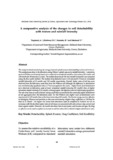Please use this identifier to cite or link to this item:
https://cris.library.msu.ac.zw//handle/11408/668| Title: | A comparative analysis of the changes in soil detachability with texture and rainfall intensity | Authors: | Kapenzi, Arnold Zirebwa, F. S. Sammie, Batanai Madanzi, Tendai |
Keywords: | Detachability, Splash Erosion, Drag Coefficient, Soil Erodibility | Issue Date: | 2014 | Publisher: | Midlands State University | Series/Report no.: | Midlands State University Journal of Science Agriculture and Technology;Vol.5 (1); p.84-94 | Abstract: | The study involved monitoring the energy load and splash erosion (detachability) of two soil textures. This analysis was done in the laboratory using Ellison’s splash cups and a rainfall simulator. Laboratory sand and Woburn soil (sandy loam) were subjected to simulated rainfall at intensities of 25 mm/hr and 120 mm/hr for 30 minutes at a time. The median drop size for the two rainfall intensities was measured using the flour pellet method. The median drop diameters were 2.26 mm and 0.73 mm for simulated rainfall intensities of 25 mm/hr and 120 mm/hr respectively. Overall, higher rates of soil loss were observed from the laboratory sand than from the Woburn soil although the difference in detachment was not statistically significant when a T-test was applied to the means . Higher levels of soil detachment were observed on laboratory sand at lower simulated rainfall intensity (25 mm/hr) than at higher simulated rainfall intensity (120 mm/hr), although again, the difference was not statistically significant. The rain drop mass as well as kinetic energy could have accounted for the nominally higher detachment of soil aggregates from the laboratory sand. For the Woburn soil, higher rates of detachment were experienced at 120 mm/hr than at the lower intensity of 25 mm/hr. The kinetic energy was less effective in dislodging Woburn soil particles as this was overcome by a higher drag coefficient at 120 mm/ hr than at 25 mm/hr. The higher soil losses from laboratory sand as compared to Woburn soil are in resonance with the fact that higher rates of soil losses are associated with soils of lower clay content and lower organic matter. However, the results also show that at some point, and in some soil type, the drag co-efficient can be used to explain an increase in soil loss when this is related to higher detachment rates. | URI: | http://hdl.handle.net/11408/668 |
| Appears in Collections: | Research Papers |
Files in This Item:
| File | Description | Size | Format | |
|---|---|---|---|---|
| kapenzi doc.pdf | 5.6 MB | Adobe PDF |  View/Open |
Page view(s)
80
checked on Apr 26, 2025
Download(s)
20
checked on Apr 26, 2025
Google ScholarTM
Check
Items in MSUIR are protected by copyright, with all rights reserved, unless otherwise indicated.



